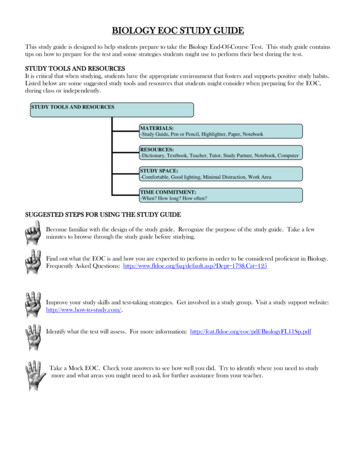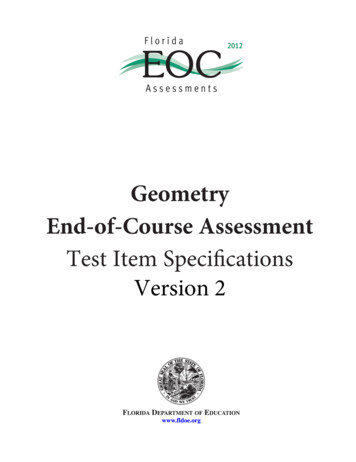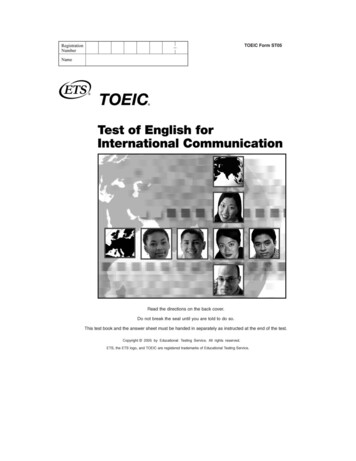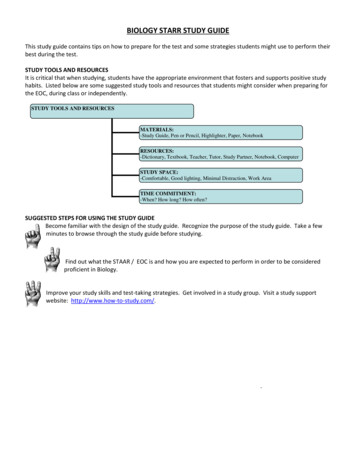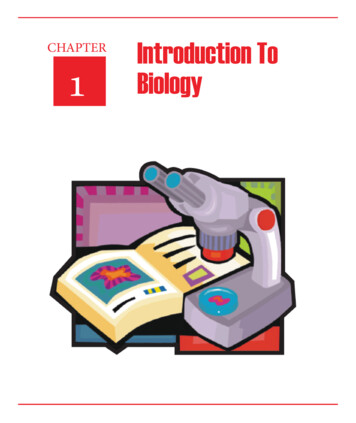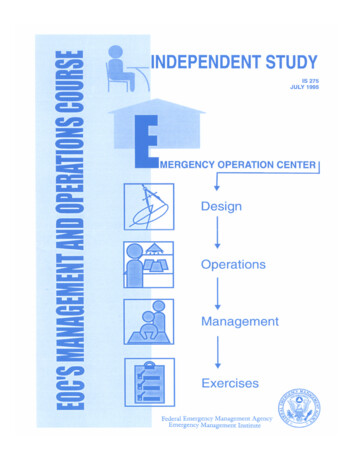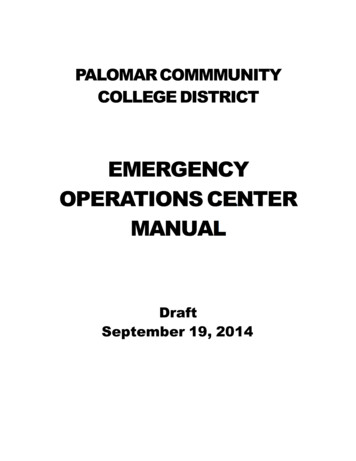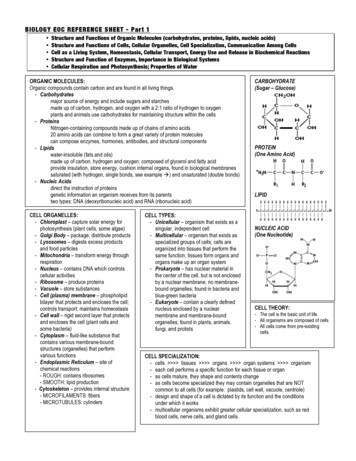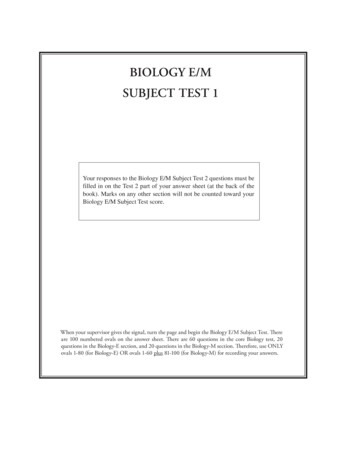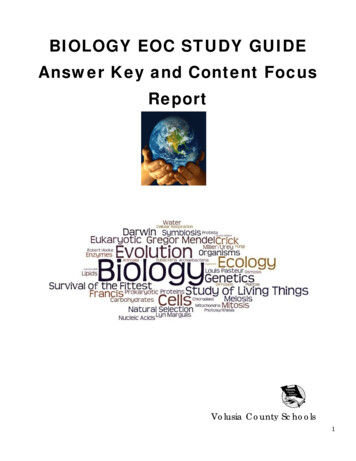
Transcription
BIOLOGY EOC STUDY GUIDEAnswer Key and Content FocusReportWaterce11u1ar ResplratlonDarwin Symbiosis ProtistaEukaryotic Gregor MendelCrfckRobertH00l eEnzymes Evolut1·on AAJmanaIMiller! LJre\:j R.mgiOrganismsEc QI Qgy1GenetiC:S 'B10 og Study EUbactel1a ArcMebact er .LipidSSurvival of the FittestFrancis Prokar!:jOtlc ProteinscarbohydratesCe II s OlffUSIOnPlan.tae Of.L1y1ng ThingsC1110roplast el0 1SMltocnondrlaPnotosynttleSiSNatural Select,onMItos1sNucleic Acids L!:Jn Margulis2015-2016Volusia County Schools1
The Biology EOC The Biology 1 EOC assessment is delivered via computer-based test.The assessment is given in one 160 session with a 10 minute break after the first 80minutes. Any student not finished by the end of the 160 minutes may continue working but,the test must be completed within the same school day.There are multiple forms of the assessment. There is a maximum of 66 multiple-choice itemson each test form.Students are provided with four-page, hard-copy work folders to use as scratch paper. Usedfolders are secure materials that must be turned in after testing.Biology EOC Study GuideThis Study Guide was developed by Volusia County teachers to help our students prepare for the FloridaBiology End-Of-Course Exam. The Florida EOC is broken down by the following Measurement Topics (MT) . Molecular and Cell BiologyClassification, Heredity,EvolutionOrganisms, Populations, Ecosystems35% of EOC25% of EOC40% of EOCThe Nature of ScienceTheories, Laws, ModelsProperties of Water,Macromolecules, EnzymesThe Cell TheoryCell Structure & FunctionCell Membrane & TransportPhotosynthesis & CellularRespirationDNA, RNA, Protein SynthesisMitosis, Meiosis The Nature of ScienceTheories, Laws, ModelsTaxonomyGeneticsOrigins of LifeEvolutionMechanisms of Change The Nature of ScienceTheories, Laws, ModelsEnergy in EcosystemsPopulation DynamicsHuman Impact on the EnvironmentPlantsBiotechnologyFetal DevelopmentParts of the BrainCardiovascular SystemImmune System2
UNIT 1: .912.N.1.1SC.912.N.1.1CONTENT FOCUSCell TheoryTechnology & ScienceCell TheoryCell TheoryProkaryotic/EukaryoticActive TransportNucleusPlant CellsRibosomeMitochondriaOsmosis: HypertonicRough ERCell MembranePlant Cell WallProtein ChannelSemi-permeableOsmosis: HypertonicMitochondriaVacuoles: Plant/AnimalProkaryoticEukaryotic/ProkaryoticPlant Cell: cell wallEukaryotic CellEukaryotic/ProkaryoticCell Membrane StructureSurface Area vs. VolumeSurface AreaLysosomeActive TransportCell WallActive TransportHypertonic/HypotonicHypotonic SolutionHomeostasisReading a GraphMaking InferencesControl GroupIndependent VariableCORRECT ANSWERCCBADADDADDBBDDBABBBDBCDBDACABCADCACDA3
UNIT 2: .L.18.7CONTENT FOCUSWater: Specific HeatWater: Surface TensionWater: Cohesion/AdhesionWater: Water ExpansionWater: CohesionWater: High Heat CapacityWater: Water ExpansionWater: Universal SolventWater: High Heat CapacityNucleic Acid FunctionsNucleic Acid FunctionsCarbohydrate StructureLipid FunctionProtein FunctionLipidNucleic AcidEnzymesProtein StructureLipid FunctionMacromoleculesNucleic AcidsProtein StructureEnzymes: TemperatureEnzymes & Activation EnergyEnzymes: TemperatureEnzymes: pHEnzymes: pHEnzymes as CatalystEnzyme BehaviorEnzyme BehaviorEnzyme ConcentrationPhotosynthesis & Cell respirationPhotosynthesis & Cell respirationPhotosynthesis & Cell respirationPhotosynthesis & Cell respirationPhotosynthesis & Cell respirationPhotosynthesis & Cell respirationPhotosynthesis reactantsPhotosynthesis reactantsPhotosynthesis productsPhotosynthesis reactantsCORRECT ANSWERCACBCDBBDDCBBCBAABDACBDCAAAAADDADBCAADCCC4
UNIT 2: .912.N.1.1.1CONTENT FOCUSAerobic respirationLeavesChloroplastCellular RespirationAnaerobic RespirationMitochondriaATP functionATP ProductionControl GroupCORRECT ANSWERCDBBACBAC5
Unit 2: 12.L.14.7SC.912.L.14.7SC.912.L.14.7CONTENT FOCUSCladogramFungiGenetic EvidenceChanges in ClassificationProtists vs. BacteriaStomataPlant Cell DivisionXylemPlant AdaptationsFunction of LeavesCambiumGuard CellPlant ReproductionSeedGuard CellStigmaPlant ExperimentCorrect AnswerBCADDBADBBDCDAABA6
Unit: Ecology#BENCHMARKCONTENT FOCUSCORRECT 12.E.7.1SC.912.E.7.1Roles: OmnivoreFood Chain: EnergyChange in Food WebDynamic EquilibriumHeterotrophsEnergy PyramidChange in Food WebFood Web: ConsumerEnergy PyramidChange Food WebDecomposerAbiotic Aquatic FactorsCompetitionSustainabilityCarrying CapacityPredator/Prey PopulationCarrying CapacityCarrying CapacityCarrying ccessionSecondary SuccessionPrimary SuccessionPioneer SpeciesPositive Human ImpactBiodiversityHuman Impact NegativeHuman ImpactSociety & EnvironmentHuman Impact NegativeNonrenewable resourcesInterconnectednessHuman Impact Long TermFertilizer PollutionWhalingAtmospheric CarbonCarbon CycleWater C.912.E.7.1Fossil FuelsB7
STUDENT:BENCHMARKCONTENT FOCUSCorrect t SquareSex-linked RecessiveCodominanceRecessive TraitGenotypic RatioPedigreeIndependent AssortmentSex-linked TraitIndependent AssortmentIncomplete DominanceDihybrid CrossDNADNADNA BasesDNA SequenceHuman GeneDNA ReplicationDNA ReplicationDNA itosisAsexual/Sexual ReproductionSexual ReproductionCancerMeiosisMetaphaseZygoteMeiosis vs. MitosisMeiosisCrossing OverChromosome 8
#BENCHMARKCONTENT hnologyParietalTemporalCommon AncestryFossil RecordsEmbryologyJaw SizeCladogramDNA EvidenceChemical EvolutionProkaryoteMiller-UreyEndosymbiant TheoryLimited ResourcesNatural SelectionMutationsNatural SelectionGenetic DisordersGenetic DriftMechanisms of Natural Sel.Genetic DiversityHuman DevelopmentFertilizationFirst TrimesterFertilizationEmbryoVas DeferensZygoteFetusFirst TrimesterEpididymisUterusBlood FlowPlaqueBlood A9
This Study Guide was developed by Volusia County teachers to help our students prepare for the Florida Biology End-Of-Course Exam. The Florida EOC is broken down by the following Measurement Topics (MT) . Molecular and Cell Biology . Classification, Heredity, Evolution Organisms, Populations, Ecosystems ;
